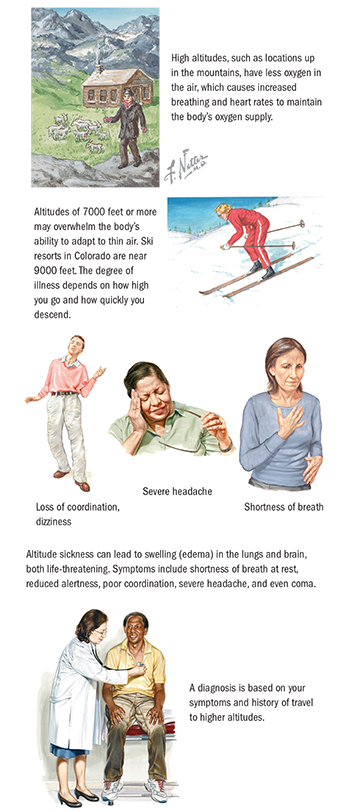
Altitude sickness is an illness that results from travel to high altitudes. Acute mountain sickness (AMS) is the most common such illness; as many as 50% of people may be affected at 15,000 feet, men and women equally. Younger adults may be more affected. AMS is more common in people with lung problems and people who usually live at very low altitudes.
High altitudes have less oxygen in the air. Breathing and heart rates increase to adjust to the thin air. High altitude may lead to swelling (edema) of hands, face, and feet. The body may not adapt to rapid exposure to 7000 to 8000 feet or more. Illnesses such as AMS and high-altitude lung (pulmonary) and brain (cerebral) edema can result.
Symptoms are headache, nausea, vomiting, shortness of breath, difficulty sleeping, dizziness, and malaise. They usually occur 6 to 48 hours after ascent. Symptoms may mimic alcohol hangover, exhaustion, or infection.
High-altitude pulmonary edema is a life-threatening condition often seen in young, fit climbers who made earlier high-altitude trips without problems. The first symptom is reduced ability to exercise. Later symptoms include cough, chest congestion, shortness of breath at rest, reduced alertness, and poor coordination.
Symptoms of high-altitude cerebral edema (brain swelling) are severe headache, impaired walking, and other neurologic problems (e.g., hallucinations and even coma).
Diagnosis is based on symptoms and a history of travel to higher altitudes.

Treatment depends on how severe the illness is and the altitude. The goal is to go down to a lower altitude quickly and safely and to begin oxygen therapy as soon as possible. Symptoms usually disappear in 1 to 3 days. Acetaminophen or aspirin can help with minor symptoms. Drugs such as acetazolamide and nifedipine can help with more severe symptoms.
For high-altitude cerebral edema, immediate descent and oxygen therapy, and often dexamethasone (a steroid), help prevent serious nerve damage or death.
Contact the following sources:
Copyright © 2016 by Saunders, an imprint of Elsevier, Inc.
Ferri’s Netter Patient Advisor